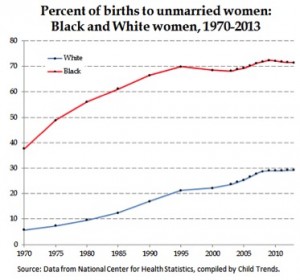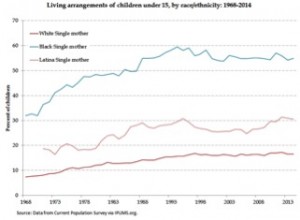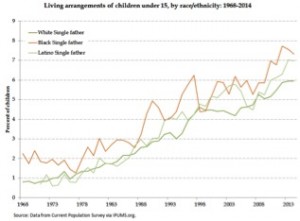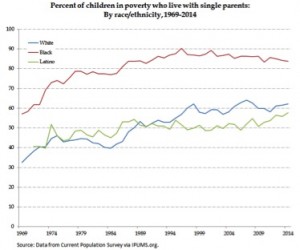This briefing paper was prepared as part of an online symposium Moynihan+50: Family Structure Still not the Problem for the Council on Contemporary Families and published jointly by CCF and the Institute for Women’s Policy Research (IWPR).
Executive Summary
In The Negro Family: The Case for National Action, published in 1965, Daniel Patrick Moynihan famously argued that the fundamental obstacle to racial equality was the instability of Black families, and especially the prevalence of single-mother families. That same year, he predicted that the spread of single-parent families would result not only in rising poverty and inequality but also in soaring rates of crime and violence. Half a century later, we report that the changes in family structure that concerned him have continued, becoming widespread among Whites as well, but that they do not explain recent trends in poverty and inequality. In fact, a number of the social ills Moynihan assumed would accompany these changes have actually decreased.
- Even as single-parent families have become more prevalent in all race/ethnic groups, especially among Black families, poverty rates have fallen, partly because of effective welfare programs, and partly because of increased education and job opportunities (especially for women). In 1967 more than 60 percent of single-mother families were poor. Today, according to new, adjusted poverty calculations, that poverty rate has been almost halved, falling to 35 percent.
- During the period of greatest change in family structure, educational levels rose for Black children and young adults. Today, almost 90 percent of Black young adults are high school graduates, compared with only about 50 percent in the 1960s; Black college completion rates have doubled, from less than 10 to almost 20 percent.
- Since 1994 juvenile crime rates have plummeted by more than 60 percent for Blacks and Whites alike, even though marriage rates have continued to fall and the proportion of children born out of wedlock has reached 40 percent.
- Although it is true that single-parent families are more likely to be poor than two-parent ones, we show that fluctuations in poverty rates since the 1990s cannot be explained by changes in family structure.
- Marriage is no protection against racial inequality. Black and Latino children in married-couple families are, respectively, three- and four-times more likely to be poor than White children in such families.
One of the legacies of the Moynihan Report has been to focus attention on changing family structure, rather than on other factors that are more amenable to policy intervention. While marriage promotion programs have proven ineffective, evidence suggests that increasing employment opportunities and wage levels, anti-discrimination policies, and social safety nets have considerable potential to reduce poverty, increase economic and educational opportunity, and decrease racial inequality.
Introduction
Daniel Patrick Moynihan, an assistant secretary in the Department of Labor, wrote his influential report, The Negro Family: The Case for National Action, in 1965 to make a case for strong action by the Johnson Administration to bring Black families up to full equality. He foresaw, correctly, that the civil rights movement, having achieved the Civil Rights Act of 1964 to provide equal opportunity, would demand movement toward equal results.
Although he was aware of the racism among Whites that would limit Blacks’ success and the high unemployment rates among Black men, Moynihan nevertheless focused on the Black family as the central cause of Black poverty, as William Chafe notes in his accompanying essay on the impact of the Moynihan Report. He presented data showing that one-quarter of Black children were born to unmarried mothers and one-quarter of Black marriages dissolved. Overall, one-quarter of families with children were headed by single mothers, and their dependence on welfare was growing even faster than the increase in Black male unemployment. He tied the low participation of Black men in the labor market and in the family to the strength of Black women, describing Black “matriarchy” as the root of the problem. The goal of national policy, he recommended, should be to strengthen the “stable” Black family (meaning the two-parent family headed by a male breadwinner). Without progress toward that goal, he warned, the situation would only grow worse, with rising rates of poverty, inequality, school failure, crime, and violence.
Since Moynihan wrote, rates of unmarried childbearing, divorce, and cohabitation have increased for all groups. For example, Whites today have about the same share of births outside marriage as Blacks did in the late 1960s — 29 percent — while the share of Black births outside marriage has risen to 72 percent (Martin et al 2015). Yet poverty rates have fallen, high school and college completion have increased substantially, and crime committed by juveniles has dropped from its 1990 highs, not only for Blacks but for all groups.
It is certainly true that inequality between the top and the bottom has widened, while racial inequality persists and has increased in some instances. But is economic instability caused by family change or does economic insecurity create serious obstacles to forming and maintaining the kind of families that people want for themselves and their children? Our evidence suggests that economic deprivation and insecurity affects family structure more than the reverse, and the evidence continues to support that conclusion.
How Have Poverty, Childbearing, Family Structure, and Unemployment Changed Across Five Decades?
How have the features of social and economic life that concerned Moynihan changed since he wrote? Figure 1, from the Columbia University Population Research Center, shows that poverty has fallen especially dramatically for female household heads, using both measures of poverty shown. The solid lines measure poverty using the official definition, which leaves out taxes and government transfer programs, while the dotted lines use the new Supplemental Poverty Measure (SPM); the SPM includes taxes and transfers and takes into account child care costs and is generally thought to be a better measure of economic well-being. In contrast to female-headed households, the poverty rate of married couples falls over time only when the SPM is used and much less dramatically. The new measure shows less poverty for both types of families because it includes government transfers, which – working as intended – help the poor and reduce poverty.
 Figure 1. Poverty rates have fallen faster when government transfers, taxes, healthcare and childcare expenses are included.
Figure 1. Poverty rates have fallen faster when government transfers, taxes, healthcare and childcare expenses are included.
By the official measure, Census data show, the poverty rate fell for all groups after the 1960s, although progress has been stagnant since the 1980s. The progress was most pronounced for Black families, who had poverty rates greater than 40 percent when Moynihan wrote, while now about 25 percent of Black families are poor. Although poverty has fallen for both female headed households and married couples, Figure 2 shows that the trend toward increasing births to unmarried women has continued, although the rate of increase has slowed since the mid-1990s for both Black and White women. Interestingly then, despite the increase in non-marital births, poverty in female-headed households has fallen, both when government transfers are counted in income and when they are not.
 Figure 2. Nonmarital births have increased for both Blacks and Whites since the 1960s, although the pace of increase has slowed in the last two decades.
Figure 2. Nonmarital births have increased for both Blacks and Whites since the 1960s, although the pace of increase has slowed in the last two decades.
Figure 3 displays the changes in work-family structure that have become well-known to us in the past several decades. The share of all families with children raised in two-parent families in which only the father works for pay has fallen from almost half of all families in 1975 to one-fifth today. Married couples with both parents working peaked in the late 1990s, approaching half of all families, up from about 36 percent in 1975. The percentage of working single-parent families, both mothers and fathers, especially single mothers has grown, peaking at more than 20 percent of the total in 2000. Figure 3 shows the effect of the job growth of the 1990s followed by the job dearth of the 2000s, which began in the 2001 recession. The percentage of dual-earner couples fell, most likely because of problems finding jobs and balancing work and familly. The unvailability of jobs is also reflected in the spike in the line representing families of all types who have no earners.
 Figure 3. Dual earner families have declined in the last decade, and those with no earners are more common.
Figure 3. Dual earner families have declined in the last decade, and those with no earners are more common.
And how have Blacks done in terms of unemployment relative to Whites? Is the Black disadvantage as great now as it was when Moynihan wrote The Negro Family? The short answer is yes – despite the growth of a much more sizable group of middle- and high-income Blacks. Moynihan reported that in the 1960s Black unemployment was about twice that of Whites and that same ratio holds today.
Figure 4. Black unemployment rates have consistently been at least twice as high as those for Whites.
Although Moynihan did not write about relative wages for Blacks and Whites, they have improved over this period. In 1967 Black women and men working full-time, year-round earned 75 percent and 65 percent respectively of their White same-sex counterparts’ earnings. Today these relative earnings have increased to 85 percent and 81 percent.[1] The relative gain for Black men has been particulary strong, having increased from 65 percent of White men’s earnings to 81 percent, or 16 percentage points. The gain in earnings for Black women relative to White women is 10 percentage points.
As we will see below, some other indicators that concerned Moynihan and his adherents – education levels and crime rates – have also shown progress even as changes in family structure progressed in the direction he warned against
Moynihan’s Legacy: Living arrangements are one key factor in children’s poverty rates
With his use of dramatic language like “tangle of pathology” and “matriarchal pattern,” Moynihan suggested that the poverty of single mothers was an outcome of deviant gender patterns rather than a result of gender discrimination. As Diana Pearce and others writing about the “Feminization of Poverty” (1978) have noted, given that women earn less than men (and this is true in all race and ethnic groups in the United States), a woman supporting a child alone is more likely to be poor than a single man supporting a child or than a married couple with a child. People typically pool resources within families and households, so family structure is one key factor that determines the economic resources available to adults and children; earnings and other sources of income are, of course, other key factors.[2] And in fact, children living with single mothers are the most likely to be below the poverty line in all racial-ethnic groups. Children living with single fathers also have higher poverty rates, but as noted above, because men earn more than women, they are not as likely to be in poverty as single-mother families.
However, family structure alone does not explain children’s poverty. Even among those with married parents, for example, Black children are more than three-times as likely to be in poverty as White children, and Latina/o children are four-times as likely to be poor as White children.
 Figure 5. For Whites, Blacks, and Latino/as, children living with single mothers have the highest poverty rates, and children living with married parents have the lowest poverty rates.
Figure 5. For Whites, Blacks, and Latino/as, children living with single mothers have the highest poverty rates, and children living with married parents have the lowest poverty rates.
Source: March 2014 Current Population Survey via IPUMS.org (showing 2014 living arrangements and poverty rates calculated for 2013 calendar-year data). Note: Children ages 0 to 14.
Assessing Moynihan’s Legacy
At issue in assessing Moynihan’s legacy is not whether family structure is important, but whether family structure is the dominant factor in determining the well-being of children. Reviewing a variety of data for the past several decades, we find that this is not the case; the graphs assembled here show relationships that are inconsistent and indicate that other important factors are also at work.
Poverty
Our analysis shows that the contribution of family structure to children’s poverty, and to racial/ethnic inequality in poverty, has not increased in the last two decades. For Black children in particular, the proportion living with single mothers and the percentage of poor children who live with single parents, haven’t increased since the mid-1990s (see Figures 6a, 6b, and 7). Although family structure is important, family structure trends are not driving recent changes in poverty rates.
 Figure 6a. The share of children living with single mothers has not increased since the mid-1990s
Figure 6a. The share of children living with single mothers has not increased since the mid-1990s
Source: Data from Current Population Survey via IPUMS.org. Note the scales are different in the two graphs.
 Figure 6b. The share of children living with single fathers has increased slowly and steadily.
Figure 6b. The share of children living with single fathers has increased slowly and steadily.
 Figure 7. The percentage of poor children who live with single parents hasn’t changed much since the 1990s.
Figure 7. The percentage of poor children who live with single parents hasn’t changed much since the 1990s.
As can be seen in Figure 8, family structure is not behind fluctuations in poverty rates, because the trends in single motherhood and poverty rates are not tightly linked. For Black children especially, there was a big drop in poverty from 1993 to 2002, and then a steep rise in the 2000s, without much change in the proportion living with single mothers. These trends show that factors beyond family structure have been important for poverty rates. These include the business cycle: strong job growth in the late 1990s encouraged the employment of single mothers and raised their wages; in 2011 as the recession that began in late 2007 continued and earnings and job prospects failed to grow strongly, and as government transfers to the poor and unemployed which had been temporarily increased were cut back steeply, child poverty ceased falling and even grew in some years of the long recession (2007-2009) and slow recovery (2009-2014).
 Figure 8. From the mid-1990s, Children’s poverty fell while share living with single mothers remained relatively high
Figure 8. From the mid-1990s, Children’s poverty fell while share living with single mothers remained relatively high
Education
In addition to poverty, progress and children’s well-being can also be assessed by looking at educational attainment trends. Here again, family structure is not the most important influence. As Figure 9 shows, as Black single-motherhood increased in the 1970s and 1980s, Black high school graduation rates increased as well. After single-motherhood rates peaked, Black college graduation rates continued to increase for two decades. These education trends are a reflection of policy changes favoring investments in public education, as well as reduced racial discrimination.
 Figure 9. School completion increased substantially for Black young adults, both when the share of Black children with single mothers was rising rapidly and when it was not
Figure 9. School completion increased substantially for Black young adults, both when the share of Black children with single mothers was rising rapidly and when it was not
Crime
In the 1980s and 1990s it was common to attribute the rising crime rates to the decline in marriage and rise of single-mother families – something Moynihan himself did throughout his career. However, since the 1990s crime rates have fallen dramatically, even while rates of marriage have fallen and the proportion of children born out of wedlock increased. In fact, since 1994, while single-motherhood rates for Black and White children have remained high, juvenile violent crime arrest rates has fallen by 62% for each group (see Figure 10). Clearly, factors beyond family structure are driving changes in crime rates.
 Figure 10. Juvenile crime rates rose in the 1980s, and then fell dramatically, while the share of children living with single parents increased or remained high
Figure 10. Juvenile crime rates rose in the 1980s, and then fell dramatically, while the share of children living with single parents increased or remained high
Marriage
Moynihan was concerned about low marriage rates in Black families – and the decline of marriage has continued in the last half century. As a result, some people assume that racial inequality is driven by differences in family structure. However, although incomes in married-couple families are higher, marriage is not a surefire protection against inequality. For example, Black and Latino children are much more likely to live in poverty than White children, regardless of their parents’ marital status. In fact, the Black/White poverty ratio for children with married parents has increased in the last decade. Today Black children with married parents are more than three-times as likely to live in poverty as White children in such families. For both Black and Latina/o children, racial inequality in poverty rates is higher now than it was in the 1980s. Clearly, racial/ethnic inequality is not just a matter of differences in family structure.
 Figure 11. Race/ethnic inequality in poverty rates is high, especially for married-couple families
Figure 11. Race/ethnic inequality in poverty rates is high, especially for married-couple families
As the data presented here show, the wellbeing of children has improved in many ways in the last 50 years. Poverty has fallen, especially when the value of federal transfer programs is added to family income; school completion at both the high school and college level has increased significantly; and juvenile violent crime arrests have fallen substantially. All these positive changes occurred while the share of children living with single mothers increased through the mid-1990s for all race/ethnic groups and remained high thereafter.
Nevertheless the stark differences that remain in the wellbeing of minority children compared with White children are too large, if our goal is to give every child an equal opportunity to succeed. And poverty rates in the United States are higher for all types of families, and school completion rates lower, than in other countries with similar wealth. Moreover, inequality between minority children and White children is growing, especially for children in married couples.
Conclusion
Although Moynihan himself was concerned about a number of problems and challenges facing Black communities, the chief legacy of his report has been to focus attention on strengthening marriage as the best route to reducing poverty and inequality. In fact, this was a preoccupation of Moynihan throughout his subsequent political career. However, the data reviewed here does not support this focus. Historic changes in family structure do pose many challenges for families, but the economic trends over the half century since Moynihan wrote largely reflect other forces – forces that are more amenable to policy intervention than family structure. Efforts to tailor welfare policy toward promoting marriage – whether through punitive measures or through programs designed to encourage stable relationships –have been ineffective at altering the trends in marriage and family structure, as evaluations of the Supporting Healthy Marriage program clearly show (Lundquist et al. 2014). Finding ways to increase employment opportunities, wage levels, anti-discrimination policies, and social safety nets has more potential to reduce poverty, increase opportunity, and reduce racial inequality. Reducing America’s high incarceration rates and making childcare more affordable for working families are also achievable goals that would reduce family instability and foster higher employment rates.
—
Ceballo, Rosario and Vonnie C. McLoyd. 2002. “Social Support and Parenting in Poor, Dangerous Neighborhoods.” Child Development 73(4):1310-1321.
Chafe, William.The Moynihan Report, Then and Now. Council on Contemporary Families. Forthcoming.
Deleire, Thomas and Ariel Kalil. 2002. “Good Things Come in Threes: Single-Parent Multigenerational Family Structure and Adolescent Adjustment.” Demography 39(2):393-413.
Glaze, Lauren E. and Laura M. Maruschak. 2008. Parents in Prison and Their Minor Children. Bureau of Justice Statistics Special Report. Accessed August 8, 2014 from <http://www.bjs.gov/content/pub/pdf/pptmc.pdf>.
Jones, Jo and William D. Mosher. 2013. “Fathers’ Involvement with their Children: Unites States, 2006-2010.” National Health Statistics Report: U.S. Department of Health and Human Services, Centers for Disease Control and Prevention.
Lundquist, Erika, JoAnn Hsueh, Amy E. Lowenstein, Kristen Faucetta, Daniel Gubits, Charles Michalopoulos, and Virginia Knox (2014). A Family-Strengthening Program for Low-Income Families: Final Impacts from the Supporting Healthy Marriage Evaluation. OPRE Report 2014-09A. Washington, DC: Office of Planning, Research and Evaluation, Administration for Children and Families, U.S. Department of Health and Human Services.
Martin, Joyce A., Brady E. Hamilton, Michelle J.K. Osterman, Sally C. Curtin, and T.J. Mathews. 2015. Births: Final data for 2013 (National Vital Statistics Reports Vol 64 No 1). Hyattsville, MD: National Center for Health Statistics.
Moynihan, Daniel P. 1965. The Negro Family: The Case for National Action. Office of Policy Planning and Research, U.S. Department of Labor. Washington, DC: U.S. Government Printing Office.
Pearce, Diana M. 1978. “The Feminization of Poverty: Women, Work and Welfare.” Urban and Social Change Review (Winter-Spring). 28-36.
Pettit, Becky and Bruce Western. 2004. “Mass Imprisonment and the Life Course: Race and Class Inequality in US incarceration.” American Sociological Review 69(2):151-69.
Sigle-Rushton, Wendy and Sara McLanahan. 2002. “Father Absence and Child Well-Being: A Critical Review.” Center for Research on Child Wellbeing Working Paper #02-20. <http://www.rwjf.org/en/research-publications/find-rwjf-research/2002/10/father-absence-and-child-well-being.html> (accessed July 28, 2014).
Western, Bruce. 2006. Punishment and Inequality in America. New York, NY: Russell Sage Foundation.
Wimer, Christopher, Liana Fox, Irwin Garfinkel, Neeraj Kaushal, JaeHyun Nam, and Jane Waldfogel. “The Changing Face of Poverty in the U.S.: The Influence of Family Structure, Employment Patterns, and the Safety Net from 1967-2012.” Paper to be presented at the Population Association of America, April 2015.
[1] Based on IWPR calculations of “Table P-38. Full-time, Year-Round Workers by Median Earnings and Sex,” U.S. Census Bureau, https://www.census.gov/hhes/www/income/data/historical/people/.
[2] Many people share resources with family members with whom they don’t live, such as paying child support or helping a relative pay rent, but most income sharing occurs within households.

Comments 1
Moynihan’s Half Century: Have We Gone to Hell in a Hand Basket? - Treat Them Better — March 26, 2015
[…] Moynihan’s Half Century: Have We Gone to Hell in a Hand Basket? […]